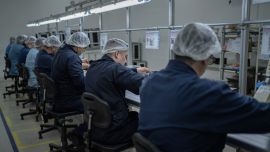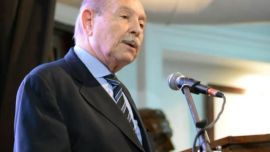More than 200 relatives of 90 fallen Argentine soldiers killed in the South Atlantic War with Britain visited Darwin Cemetery on the Malvinas (Falkland) Islands on Monday, to pay homage to their loved ones and see their final resting places.
Fathers, mothers, siblings and other relatives of the fallen travelled early in the morning on a humanitarian flight from Ezeiza Airport to RAF Mount Pleasant.
The visit was made possible by an agreement finalised between the two nations in 2016, when Britain and Argentina agreed to try and identify the remains of unknown soldiers buried in the cemetery.
The emotional trip, funded by businessman Eduardo Eurnekian and Aeropuertos Argentina 2000, was the culmination of a process led by the International Committee of the Red Cross (ICRC), which managed to identify solders from 121 tombs that previously bore a simple inscription in English on each gravestone: “Argentine soldier known only to God.”
In total there are 237 graves in the cemetery. There are still more than 30 sets of unidentified remains, which the ICRC is still hoping to identify.
Two of the main drivers for the identification process, which marked a new era in the diplomatic relationship between Argentina and Britain, were the No Me Olvides NGO, a group created by veterans and relatives in 2008, and the Comisión de Familiares de los Caídos en Malvinas NGO.
Some families of the fallen troops had long distrusted the idea of sending experts to the islands to identify their war dead. But any scepticism was eventually overcome.
“One day, my mum finally told me: ‘Who am I to impede another mother from finding her son,’” said María Fernanda Araujo, the leader of the Comisión de Familiares de los Caídos en Malvinas, who was nine when her brother Eduardo was killed in the war.
“We had to make other families understand that this was not impossible,” she said.
Under the ICRC’s watch, a multinational team of 14 experts – including both Argentine and British forensic experts – exhumed, analysed, sampled and documented remains over an exhaustive two-month period that began in June 2017. The samples were analysed and then compared with DNA samples from family members of some of the dead soldiers at a laboratory in Argentina. Laboratories in Britain and Spain conducted quality control of the DNA analyses.
For the families of the fallen, Monday’s event was a chance to see the graves of their loved ones. At a bilateral level, the trip was further proof of improving relations between Argentina and Britain.
‘CLOSER TO THEM’
The group of relatives arrived just after 8am at the cemetery, travelling from RAF Mount Pleasant, the remote islands’ airport, via coach, accompanied by a small delegation that included journalists, doctors, psychologists and officials, including Human Rights Secretary Claudio Avruj.
The government official, speaking prior to the trip, said the event was “a sample of what can be achieved through dialogue.”
“A huge step has also been taken by Argentina to fulfill a pending commitment with the families and the heroes of Las Malvinas,” said Avruj.
“This is the road that Argentina and the world needs to take – dialogue, encounters, mutual respect and recognition of our fellow men,” he said. “This way, our societies will be better, more just, and peaceful.”
Foreign Minister Jorge Faurie spoke to the families at midnight on Sunday, hours before they departed.
“Tomorrow (Monday) you will be able to kneel down and, in touching that land, be closer to them,” he said in reported comments.
“Nothing will change the story, nothing will change the loss that each of you had,” he continued, “but perhaps somehow being there, in front of a plaque with the name and surname, will have another value.”
Emotions ran high as the trip drew closer. María Reyes Lobos is the sister of a fallen soldier whose grave lies in Darwin Cemetery.
“We are going to end our grief after nearly 36 years,” she told reporters, as she shared details about her brother to members of the press before departing for the islands.
“We found out that he was in Malvinas from a letter he sent when he was already there. Until that moment they had told us he was in his barracks, but they had already sent him off,” she continued.
The war began when troops dispatched by then-Argentine dictator Leopoldo Galtieri occupied the archipelago on Friday, April 2, 1982. A British expeditionary force was sent to the islands and took them back.
The war lasted two months, one week and five days. In all, the war claimed the lives of 649 Argentines and 255 British soldiers.
Britain refuses to negotiate over the sovereignty of the islands today, arguing that the nearly 3,000 people living on the islands voted in a referendum in 2013 to remain part of Britain. Argentina still claims sovereignty over the islands and has enshrined its demand in its Constitution.
CEREMONY
To the islanders who live there, Darwin Cemetery is known as “the Argentine cemetery.” It sits in the middle of a hill, west of the Darwin Settlement, close to the location where the fierce Battle of Goose Green took place.
Monday’s visit was brief, lasting less than three hours. A brief ceremony was held, during which the auxiliary bishop of Buenos Aires, Enrique Eguía Seguí, delivered a Catholic Mass. Anglican and Catholic priests from the islands, Reverend Mercer and Father John Wisdom respectively, were also present. At the close of the ceremony, Scottish Guards played bagpipes.
It was an emotional day for those who were able, after so many years, to stand by graves they know to be holding the remains of their kin.
“It’s a very strong, new feeling because I found my son,” said Dalal Abd, the mother of soldier Marcelo Daniel Massad, as she held back tears. Daniel died on June 11, 1982 in one of the fiercest battles of the short but costly war.
“I was able to speak to him, as a mother, and ask him questions,” she said. “I have a feeling of peace because I know where he is after almost 36 years of so many struggles. I know he’s here now, with his cross.”
Two groups of family members, who asked to remain nameless said simply: “They were peers. They died together,” as they stood before the fallen’s graves.
Virginia Oviedo, the nephew of fallen soldier Héctor Oviedo said: “We were with him. We cried. It was the first time we saw a plaque with his name.”
Fernando Ramírez, a relative of fallen soldier Rubén Ramírez, said he experienced “a moment of emotion and sadness. I had been [to the Darwin cemetery] on other occasions, but he hadn’t been identified. It only said ‘Argentine Soldier only known to God.”
Sergio Aguirre, son of volunteer soldier Miguel Aguirre, who died in the war at 52 years of age, said that when he can sleep again, he will feel “peace. I spent 36 years thinking my father’s body was in the sea.”
María Fernanda Araujo, speaking at the site, asked for continued trips to the islands.
“Now we are asking for more trips because several mothers and fathers whose children are buried here remain back on the continent.”
She said the trip had been unforgettable.
“The moment we are experiencing will remain engraved in our hearts for the rest of our lives. It closes a wound and begins a new stage, it’s the beginning of something new”
“As long as we leave behind rosaries and some of our heroes, then they will continue to be the last thread of severeignty. When the whole world sees this cemetery, they will know a group of men had the courage to face the enemy.”
UNTOUCHED
When the war ended on June 14, 1982, most Argentine bodies were left untouched on the battlefield or in temporary graves during the southern winter. Britain tried for months to send them to Buenos Aires, but the Argentina’s ruling military junta said they were already in their homeland.
Then-British prime minister Margaret Thatcher finally agreed to build a cemetery. Geoffrey Cardozo, then a 32-year-old captain in the British Army, was ordered in January 1983 to recover and rebury the dead.
“They very quickly became my boys because they were orphans. Their mothers and fathers were not on the island and I was the only one who could look after them,” Cardozo, now a retired colonel, this week.
“And so I took great care to bury them, to look after them. And every step I took along the way with each body, I had in my mind their mothers, their families.”
Cardozo assembled a team of British funeral directors that rappelled into minefields from helicopters and dug up mass graves to recover Argentine corpses. They carefully prepared each one for reburial in individual coffins.
Now, 36 years later, his work in those days has helped Argentine families to be able to finally know where their loved ones’ final resting place is.
Speaking on Monday, Cardozo said he was satisfied that he had been able to help “close the wounds.”
“These kinds of things are impossible to forget, but it’s possible to make it less painful,” he added.
Last Friday, prior to their trip to the islands, government officials and the relatives paid tribute to Cardozo. Addressing them afterwards, the retired colonel said he felt “a great joy, a great tranquility.”
“I would have never imagined 35 years later that we would achieve this kind of success,” Cardozo said as the families around his began to cry. “It’s formidable, miraculous.”


























Comments